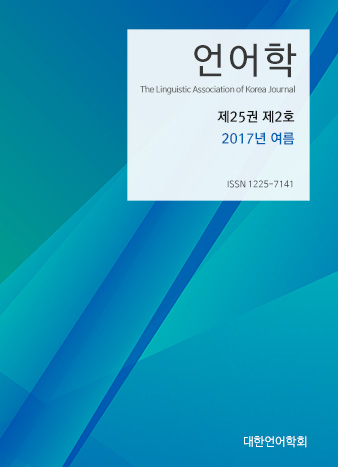대한언어학회 전자저널
25권 2호 (2017년 6월)
- 영어 유성 자음의 경음 차용에 대한 한국어 음운제약 효과
-
오미라
Pages : 121-141
Abstract
Oh, Mira. (2017). The effect of Korean phonological constraints on tensification of English voiced stops. The Linguistic Association of Korea Journal, 25(2), 121-141. English voiced stops are variably adapted as either Korean tense or lax stops only when they occur in the word-initial prevocalic position in English. I argue that native phonology and phonetic similarity jointly play a role in English voiced stop tensification. Overrepresentation of the tense-tense sequence observed in the Korean lexicon is at work in the adaptation of English voiced stops as the tense stops in Korean. To prove the effect of the preferred tense-tense sequence on the adaptation of English voiced stops into Korean, I conducted a survey experiment where the extent of tense adaptation was measured depending on whether the following consonant is [s] or [s]. English voiced fricatives are not adapted as tense stops in Korean. That suggests that phonetic similarity between the source and the loan sounds is crucially taken into consideration in loanword adaptation.
Keywords
# 영어유성자음(English voiced stops) # 외래어 차용(loanword adaptation) # 경음-경음 연쇄 선호(overrepresentation of tense-tense sequence) # 음성적 유사성(phonetic similarity) # 한국어 사&
References
- 국립국어원. (1991). 외래어 사용실태조사: 1990년도.
- 국립국어원. (2007). 외래어 표기법.
- 김숙자 (2007). 일본어 외래어. 서울: 제이엔씨 출판사.
- 신승용. (2003). 영어 차용어의 자음 대응 원칙에 대한 고찰, 국어국문학, 135, 71-99.
- 신지영. (2014). 한국어의 말소리. 서울: 도서출판 박이정.
- 이종극. (1937). 모던 조선외래어 사전. 서울: 한성도서 주식회사.
- Chang, C. (2013). The production and perception of coronal fricatives in Seoul Korean. Korean Linguistics, 15(1), 1-46.
- Cho, T. (1996). Vowel correlates to consonant phonation: an acoustic-perceptual study of Korean obstruents. Unpublished master’s thesis, University of Texas at Arlington.
- Cho, T., Jun, S., & Ladefoged, P. (2002). Acoustic and aerodynamic correlates of Korean stops and fricatives. Journal of Phonetics, 30(2), 155-190.
- Chung, H., Kim, K., & Huckvale, M. (1999). Consonantal and prosodic influences on Korean vowel duration. In Proceedings of Eurospeech, 99. Budapest, Hungary.
- Daland, R., Oh, M., & Kim, S. (2015). When in doubt, read the instructions: Orthographic effects in loanword adaptation. Lingua, 159, 70-92.
- Hyman, L. (1970). The role of borrowing in the justification of phonological grammars. Studies in African Linguistics, 1, 1–48.
- Ito, C., Kang, Y., & Kenstowicz, M. (2006). The adaptation of Japanese loanwords into Korean. MIT Working Papers in Linguistics, 52, 65-104.
- Ito, J., & Mester, A. (1995). Japanese phonology. In J. A. Goldsmith (Ed.), The Handbook of Phonological Theory, 817-838. Cambridge, Mass.: Blackwell Publishers Ltd.
- Ito, J. (2007). Morpheme structure and co-occurrence restrictions in Korean monosyllabic stems. Studies in Phonetics, Phonology and Morphology, 13, 373-394.
- Ito, J. (2014). Compound tensification and laryngeal co-occurrence restrictions in Yanbian Korean. Phonology, 31, 349-398.
- Kang, K. (2000). On Korean fricatives. 음성과학, 7(3), 53-68.
- Kang, H., & Oh, M. (2016). Dynamic and static aspects of laryngeal co-occurrence restrictions in Korean, Studies in Phonetics, Phonology and Morphology, 22(1), 3-34.
- Kang, Y. (2003). Perceptual similarity in loanword adaptation: English postvocalic word-final stops in Korean, Phonology, 20, 1-56.
- Kang, Y. (2008). Tensification of voiced stops in English loanwords in Korean. In Harvard Studies in Korean Linguistics XII.
- Kang, Y., Kenstowicz, M., & Ito, C. (2007). Hybrid loans: a study of English loanwords transmitted to Korean via Japanese. Paper presented at the 4th Seoul International Conference on Phonology and Morphology, Hanyang University, Korea.
- Kawahara, S. (2008). Phonetic naturalness and unnaturalness in Japanese loanword phonology. Journal of East Asian Linguistics, 17, 317–330.
- Kim, D. (2002). The vowel length as a function of the articulatory force of the following consonants in Korean. Speech Sciences, 9(3), 143-154.
- Kim, H. (2016a). Contextual distribution of English loanword word-initial tensification in Korean. Studies in Phonetics, Phonology and Morphology, 22(2), 245-288.
- Kim, H. (2016b). Phonological trends in English loanword word-initial tensification in Korean. 국제음운론학회, 서울대학교.
- Kim, S. (1999). Subphonemic duration difference in English /s/ and few-to-many borrowing from English to Korean. Doctoral dissertation, University of Washington.
- Kim, S. (2003), A[n] analysis of writing loanwords in the dictionary of modern-Joseon-loanwords. [In Korean], The Society of Ewha Korean Language and Literature, 21, 249-271.
- Klatt, D. (1975). Voice onset time, frication, and aspiration in word-initial consonant clusters. Journal of Speech and Hearing Research, 18, 686-706.
- LaCharité, D., & Paradis, C. (2005). Category preservation and proximity versus phonetic approximation in loanword adaptation. Linguistic Inquiry, 36, 223-258.
- Nearey, M., & Rochet, B. (1994). Effects of place of articulation and vowel context on VOT production and perception for French and English stops. Journal of International Phonetic Association, 24(1), 1-19.
- Oh, M. (2004). English stop adaptation as output-to-output correspondence. Phonological Studies, 9, 165-172. The Phonological Society of Japan.
- Oh, M. (2009). The phonetics and phonology of English voiced stop. SFU Working Papers in Linguistics. Simon Fraser University, http://www.sfu.ca/gradlings/working-papers/wp_2.html.
- Shin, S. (1997). Umlaut in Kyungsang Korean. In H.-M. Sohn, & J. Haig (Eds.), Japanese and Korean Linguistics VI, 283-302. Stanford, CA: CSLI Publications and SLA.
- Silva, D. (2006). Variation in voice-onset time for Korean stops, Korean Linguistics, 13, 1-19.
- Silverman, D. (1992). Multiple scansions in loanword phonology: Evidence from Cantonese. Phonology, 9, 289-328. Cambridge University Press.
- Shin, S., & Davis, S. (2004). Where have all the lax stops gone?: on the possible restructuring of the Korean stop system. In Japanese and Korean Linguistics 13. Stanford, CA: CSLI.
- Vendelin, I., & Peperkamp, S. (2006). The influence of orthography on loanword adaptations. Lingua, 116, 996-1007.
